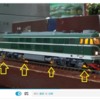Hi guys, not sure what forum to put this on, so I went here....
There is a company on eBay selling an HO scale locomotive that includes "simulated brake spark".
The referenced item can be found here.
There used to be a video of this train, showing the various included systems, including the brake spark during production testing. I couldn't find it and have asked the owner of the store for the link if available. I will post if I get it.
I have seen postings on the OGR forums about simulating the arcing of subways and will be working on a simulation of that for my own layout.
Wondering if anybody has tried simulating brake spark and if so, how they did it.
-Todd














